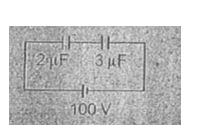A capacitor of capacitance C is charged to a potential differece V0. The terminals of the charged capacitor are then connected to those of an uncharged capacitor of capacitance C/2.
a. Compute the original charge of the system.
b. Find the final potential differce across each capacitor.
c. Find the final energy of the system.
d. Calculate the decrease in energy when the capacitors are connected.
e. Where did the ''lost'' energy go?
Let's solve the problem step by step.
Step 1: Compute the Original Charge of the System
The original charge Q on the capacitor can be calculated using the formula:
Q=C⋅V0
where C is the capacitance of the charged capacitor and V0 is the initial potential difference.
Step 2: Find the Final Potential Difference Across Each Capacitor
When the charged capacitor is connected to the uncharged capacitor, charge will redistribute until the potential difference across both capacitors is equal.
Let:
- Q1 be the charge on the capacitor with capacitance C after connection.
- Q2 be the charge on the capacitor with capacitance C2 after connection.
Using the conservation of charge:
Q=Q1+Q2
And the relationship between charge, capacitance, and potential difference:
V1=Q1CandV2=Q2C2=2Q2C
Since V1=V2:
Q1C=2Q2C
This simplifies to:
Q1=2Q2
Substituting Q1 in the charge conservation equation:
Q=2Q2+Q2=3Q2⟹Q2=Q3
Then,
Q1=2Q2=2⋅Q3=2Q3
Now, we can find the final potential difference across each capacitor:
V1=Q1C=2Q3C=2Q3C
Substituting Q=CV0:
V1=2CV03C=2V03
For the second capacitor:
V2=Q2C2=Q3C2=2Q3C
Substituting Q=CV0:
V2=2CV03C=2V03
Step 3: Find the Final Energy of the System
The energy stored in a capacitor is given by:
U=12CV2
Calculating the energy for both capacitors:
1. For the first capacitor:
U1=12C(2V03)2=12C⋅4V209=2CV209
2. For the second capacitor:
U2=12(C2)(2V03)2=12⋅C2⋅4V209=CV209
Total final energy Uf:
Uf=U1+U2=2CV209+CV209=3CV209=CV203
Step 4: Calculate the Decrease in Energy
The initial energy Ui of the charged capacitor was:
Ui=12CV20
The decrease in energy ΔU:
ΔU=Uf−Ui=CV203−12CV20
Finding a common denominator (6):
ΔU=2CV206−3CV206=−CV206
Step 5: Where Did the "Lost" Energy Go?
The lost energy is dissipated as heat due to the resistance in the connecting wires and the internal resistance of the capacitors. This energy is transformed into thermal energy, which is why we observe a decrease in the total energy of the system.
The original charge Q on the capacitor can be calculated using the formula:
Q=C⋅V0
where C is the capacitance of the charged capacitor and V0 is the initial potential difference.
When the charged capacitor is connected to the uncharged capacitor, charge will redistribute until the potential difference across both capacitors is equal.
- Q1 be the charge on the capacitor with capacitance C after connection.
- Q2 be the charge on the capacitor with capacitance C2 after connection.
Q=Q1+Q2
And the relationship between charge, capacitance, and potential difference:
V1=Q1CandV2=Q2C2=2Q2C
Since V1=V2:
Q1C=2Q2C
This simplifies to:
Q1=2Q2
Substituting Q1 in the charge conservation equation:
Q=2Q2+Q2=3Q2⟹Q2=Q3
Then,
Q1=2Q2=2⋅Q3=2Q3
V1=Q1C=2Q3C=2Q3C
Substituting Q=CV0:
V1=2CV03C=2V03
V2=Q2C2=Q3C2=2Q3C
Substituting Q=CV0:
V2=2CV03C=2V03
The energy stored in a capacitor is given by:
U=12CV2
Calculating the energy for both capacitors:
1. For the first capacitor:
U1=12C(2V03)2=12C⋅4V209=2CV209
2. For the second capacitor:
U2=12(C2)(2V03)2=12⋅C2⋅4V209=CV209
Uf=U1+U2=2CV209+CV209=3CV209=CV203
The initial energy Ui of the charged capacitor was:
Ui=12CV20
The decrease in energy ΔU:
ΔU=Uf−Ui=CV203−12CV20
Finding a common denominator (6):
ΔU=2CV206−3CV206=−CV206
The lost energy is dissipated as heat due to the resistance in the connecting wires and the internal resistance of the capacitors. This energy is transformed into thermal energy, which is why we observe a decrease in the total energy of the system.
Topper's Solved these Questions
- CAPACITOR AND CAPACITANCEBOOK - CENGAGE PHYSICS ENGLISHCHAPTER - CAPACITOR AND CAPACITANCEEXERCISE - Subjective
24 Videos
- CAPACITOR AND CAPACITANCEBOOK - CENGAGE PHYSICS ENGLISHCHAPTER - CAPACITOR AND CAPACITANCEEXERCISE - Single Correct
49 Videos
- CAPACITOR AND CAPACITANCEBOOK - CENGAGE PHYSICS ENGLISHCHAPTER - CAPACITOR AND CAPACITANCEEXERCISE - Exercise 4.1
13 Videos
- ATOMIC PHYSICSBOOK - CENGAGE PHYSICS ENGLISHCHAPTER - ATOMIC PHYSICSEXERCISE - ddp.4.3
15 Videos
- CENGAGE PHYSICS DPPBOOK - CENGAGE PHYSICS ENGLISHCHAPTER - CENGAGE PHYSICS DPPEXERCISE - subjective type
51 Videos
Similar Questions
A capacitor of capacitance C1 is charged to a potential difference V and then connected with an uncharged capacitor of capacitance C2 a resistance R. The switch is closed at t = 0. Choose the correct option(s):
View SolutionFind charge on each capacitor and potential difference across each capacitor .

View Solution
Knowledge Check
A capacitor or capacitance C1 is charge to a potential V and then connected in parallel to an uncharged capacitor of capacitance C2. The fianl potential difference across each capacitor will be
AC1VC1+C2BC2VC1+C2C1+C2C1D1−C2C1
A capacitor of capacitance C is charged to a potential V. The flux of the electric field through a closed surface enclosing the capacitor is
View SolutionA capacitor of capacitance C is charged to a potential difference V0. The charged battery is disconnected and the capacitor is connected to a capacitor of unknown capacitance Cx. The potential difference across the combination is V. The value of Cx should be
View SolutionA parallel plate capacitor of capacitance C has been charged, so that the potential difference between its plates is V. Now, the plates of this capacitor are connected to another uncharged capacitor of capacitance 2C. Find the common potential acquired by the system and loss of energy.
View SolutionA capacitor of capacitance C carrying charge Q is connected to a source of emf E. Finally, the charge on capacitor would be
View SolutionAn ideal capacitor of capacitance 0.2μF is charged to a potential difference of 10V. The charging battery is than disconnected. The capacitor is then connected to an ideal inductor of self inductance 0.5mH. The current at a time when the potential difference across the capacitor is 5V is :
View SolutionA capacitor of capacitance C0 is charged to potential V0. Now it is connected to another uncharged capacitor of capacitance C02. Calculate the heat loss in this process.
View SolutionA capacitor of capacity 20microF is charged upto 500V and and disconnected from cell. Now this charged capacitor is connected to another capacitor of capacitance C If final common potential is 20V then find the capacitance C.
View Solution
